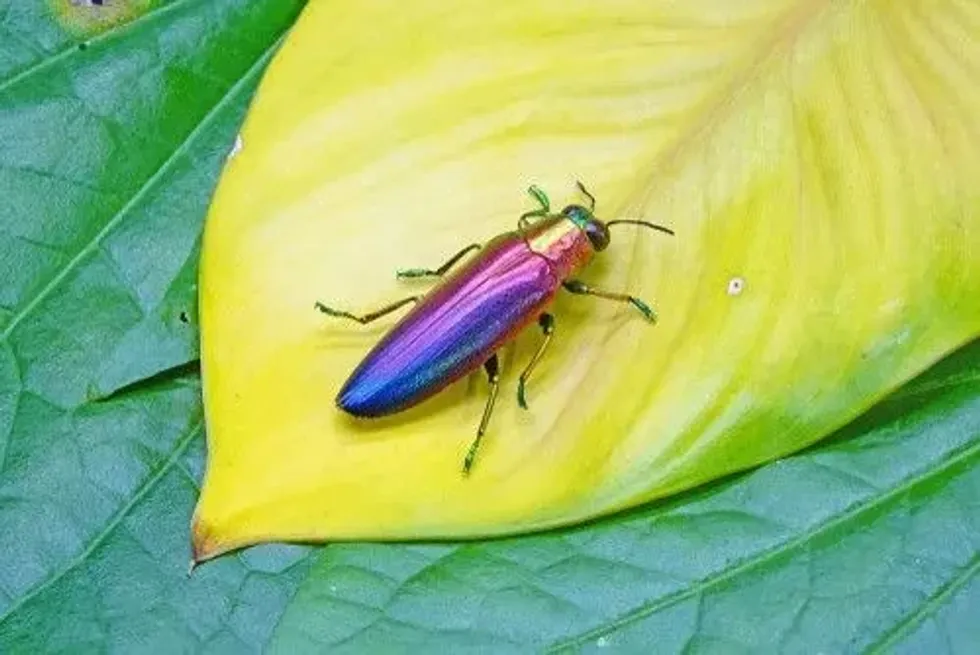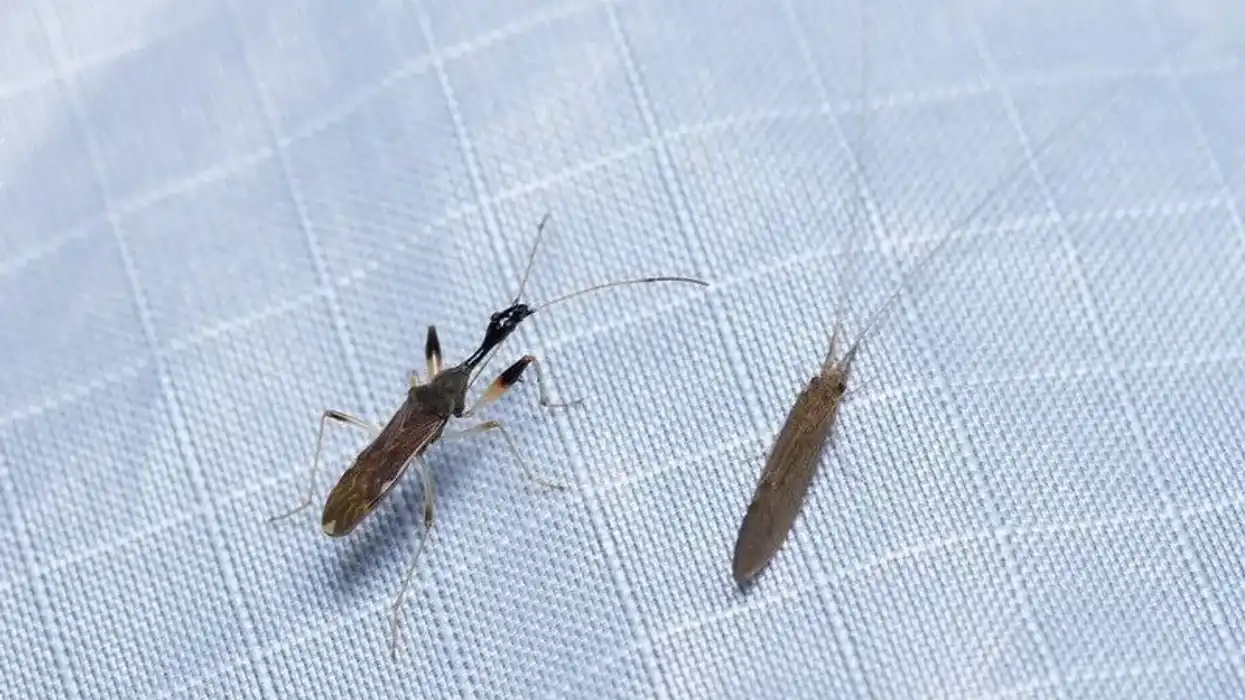The jewel beetle has a shiny, brilliant color on its chitinous shell called the carapace. Buprestidae is their scientific name, but they are known as jewel beetles or metallic wood-boring beetles.
The larvae are known as flat-headed borers. There are 15,500 species known in 775 genera.
Insect collectors are very passionate about some of the most vibrantly colored large beetles in this species. In many countries like Japan, Thailand, and India, the colorful shells are used for making beetle wing jewelry.
These bugs are mostly cylindrical, elongated, or ovoid in shape. They also come with interesting and complicated patterns along with their brilliant colors.
The bright colors of the jewel beetle are not because of the pigments in the exoskeleton but it is caused by structural coloration in which the microscopic texture of their cuticle selectively reflects specific frequencies of light in a particular direction.
These include the Inaba jewel beetle, green jewel beetle, new leaf jewel beetle, golden jewel beetle, rainbow jewel beetle, purple jewel beetle, emerald jewel beetle, and more.
Some of these jewel beetles, also known as metallic-wood borer beetles, come under the serious pest category due to their capabilities to cause serious damage on a large scale. One such pest jewel beetle is the emerald ash borer.
They can see infrared light from a distance which helps them to get closer to a forest fire. They come in colors like reds, greens, blues, and purples. Jewel beetles are known to thrive on deadwood.
They lay their eggs there and develop their various larvae stages inside the deadwood. After reading about these bright color beetles, you may also look at atlas beetle facts and click beetle facts.
Jewel Beetle Interesting Facts
What type of animal is a jewel beetle?
The jewel beetle is a type of beetle species or a bug found in the forest trees in the northern hemisphere. They are famous for their vividly colored bodies in jewel or metallic colors. Some of the subspecies include the Japanese jewel beetle, giant jewel beetle, African jewel beetle, Australian jewel beetle, and more.
What class of animal does a jewel beetle belong to?
The jewel beetle belongs to the insect class of animals, the family Buprestidae. They are brilliantly colored insects whose species are known as pests, too, which cause great economic damage to farmlands and gardens. These insects are widely found in forest trees.
How many jewel beetles are there in the world?
The exact number of jewel beetles across the world would be difficult to calculate as they are difficult to calculate. There are hundreds of subspecies and genera for this species which makes it all the more difficult to come up with exact numbers.
Where does a jewel beetle live?
The jewel beetle lives in farmland, garden, forest, jungle, or woodlands. They may live on a plant or tree that is dying. Some species are attracted to recently burned forests and lay their eggs there. They are known as tough species, that can thrive in adverse conditions.
What is a jewel beetle's habitat?
The habitat of the jewel beetle could be any region with abundant plants and trees. That is, they feed and live on the ground as well. They are found on a dying plant or a dying branch of a tree.
Who do jewel beetles live with?
The jewel beetle lives alone most of the time. The jewel beetle habitat may be in the vicinity of other beetles and insects, but they lead a solitary existence until the breeding season. Most beetles spend their whole life in the area or around it.
How long does a jewel beetle live?
The adult jewel beetle lives for three weeks. They may live for a few days or a few weeks. At the pupal stage, the beetle can live for a longer duration even in adverse conditions.
How do they reproduce?
The mating ritual of the jewel beetle is as good as a Roman Gladiator. In certain species, they may fight to the death to win mating rights.
Males may fight amongst themselves, or females will fight each other to win mating rights. The strongest one that survives these battles will mate. The mating process usually lasts for a few minutes to several hours.
After the mating is over, the female will go to the bark of a tree to lay her eggs. The eggs are laid on the host trees, in the cracks present in the bark of the respective trees.
The life cycle of jewel beetles can be called complete metamorphosis and is divided into four stages, which are egg, larva, pupal, and adult. The larvae of these beetles are known as flat-headed borers, too.
Female jewel beetles will lay 20-30 eggs on host trees, usually in the tiny crevice of the bark or under a shoot or a stem. Beetle larvae then grow into a worm-like appearance and are voracious eaters.
As they begin to grow, they will discard their outer covering, which is known as the exoskeleton, to have more room. This process is called molting and can happen seven to ten times before it enters the pupal stage. In the pupal stage, the larvae from the pupa or cocoon and lay dormant in it.
This is the most transformative stage for the growth of the beetle. This is the time when the larvae take the shape of the adult beetle.
The jewel beetle can take anywhere between days to years to grow into a full-fledged adult. After crossing this stage the jewel beetle attends full adulthood.
What is their conservation status?
The conservation status of the jewel beetle is of the Least Concern. We can find them in many places; however, some subspecies that are considered pests may be exterminated using natural or chemical insecticides, causing severe population loss for them.
Jewel Beetle Fun Facts
What do jewel beetles look like?
Jewel beetles are easily recognized and collected for their shiny brilliant-colored bodies. They come in shiny, metallic tones with different patterns and colors. The more spectacular the color, the more sought after they are by insect collectors.
How cute are they?
Jewel beetles are mesmerizing to look at. They are a collectors’ delight due to the various metallic colors or jewel-tone they come in. They are cute and worthy of collecting too.
How do they communicate?
Jewel beetles may make a buzzing sound when they fly. There may be some vocal or non-vocal communication before or during their mating seasons. Apart from that, they may not communicate that much.
How big is a jewel beetle?
The average jewel beetle would not be more than 0.75 in in length. There are some who grow to the length of 3 in, which is large in the beetle world.
How fast can a jewel beetle move?
The jewel beetle moves fast when they are pursued by a predator. Otherwise, they are known to hide or stay on their plant most of the time.
How much does a jewel beetle weigh?
The jewel beetle may weigh around 0.004 lb. They are found in various sizes and will weigh differently depending on the species.
What are their male and female names of the species?
The male and female jewel beetle do not have any specific names for them.
What would you call a baby jewel beetle?
The baby jewel beetle may be called larvae or flat-headed borers. Jewel beetle life cycle consists of four stages of metamorphosis, namely, adult, larvae, pupa, and adult. Only a little is known about the larval stage of this beetle species other than that they bore into the native plant species.
What do they eat?
The jewel beetle diet comprises the juiciest part of the plant. Some species eat from a dying tree or a branch. The larvae can eat roots, logs, stems, and leaves from any plant or tree. Some species of flat-headed borer from the jewel beetle family eat spruce, fir, and hemlock.
Are they rare?
Some subspecies of the jewel beetles are extremely rare, and some may be found only in specific locations. There are various types of jewel beetles around the world and not all are found everywhere, which makes them rare.
Would they make a good pet?
The jewel beetles are collectors’ items. The rare brilliantly colored ones are most sought after by insect collectors. However, they have very small adult lives.
Did you know...
The giant jewel beetle is found in the Limpopo province of South Africa and can grow to a size of 20 mm, and it is a protein-rich delicacy in the villages there.
The jewel beetle carapace is used as a decorative piece of jewelry in many Southeast Asian countries. The Marrakech beetle from Central America is worn as a living decoration.
How to tell a female jewel beetle from a male?
There may not be much difference between a male and a female jewel beetle. However, females have a larger body compared to males and they can’t fly, but the males can fly. Females possess a shiny appearance on their bodies to which a male can recognize while flying around.
How much is a jewel beetle worth?
The rarest jewel beetles with a unique color and pattern may cost as high as $450. They are expensive as they are highly prized by collectors and insect lovers. The vivid colors of their skin combined with complex patterns and size make them a must-have item in their collection.
Here at Kidadl, we have carefully created lots of interesting family-friendly animal facts for everyone to discover! Learn more about some other arthropods including water beetle, or ground beetle.
You can even occupy yourself at home by drawing one on our jewel beetle coloring pages.










